Games between Manchester City and Arsenal are often defined by City’s press and how the Gunners deal with it. Usually, City have a unique ‘out to in’ style of pressing where the wingers, Kelly and Hemp, start wide when the opponent builds before swooping in to press from wide positions. In the reverse fixture in November, Arsenal started with Katie McCabe at right-back. It was the first time she had started at right-back this season.
When Arseblog News asked Eidevall about this selection choice, he said, ‘When we have played City before we have been tricked into playing into wide areas too quickly and they are really strong there and use the sides so well. By playing Katie on her other side, naturally, we get more central passes. That means we connect better and the longer we can stay central against City and play the ball out wide later, that creates better situations.’
Building centrally was a key component in this game too, especially with City missing usual centre-forward Bunny Shaw. Though Eidevall didn’t select McCabe at right-back (though she played there for a while in the second half), keeping the ball away from wide areas early in the build-up phase was a key part of Arsenal’s game plan. Let’s look at some examples.

From Arsenal’s first goal kick, Codina rolls the ball back in to Zinsberger and we see the City press, with Fowler pressing in from the right and Hemp positioned on the left. Arsenal have a box shape between their centre-halves and their central midfielders.

Zinsberger opts to play through centrally to Pelova who has run off the blind side of Hemp and away from her usual ‘out to in’ pincer movement.

Cooney-Cross then makes a blind side run off Kelly and Pelova then stays central by looking to pass to her midfield partner Cooney-Cross. Arsenal’s midfield pair consistently looked for these blindside runs away from the City forwards as they played out.
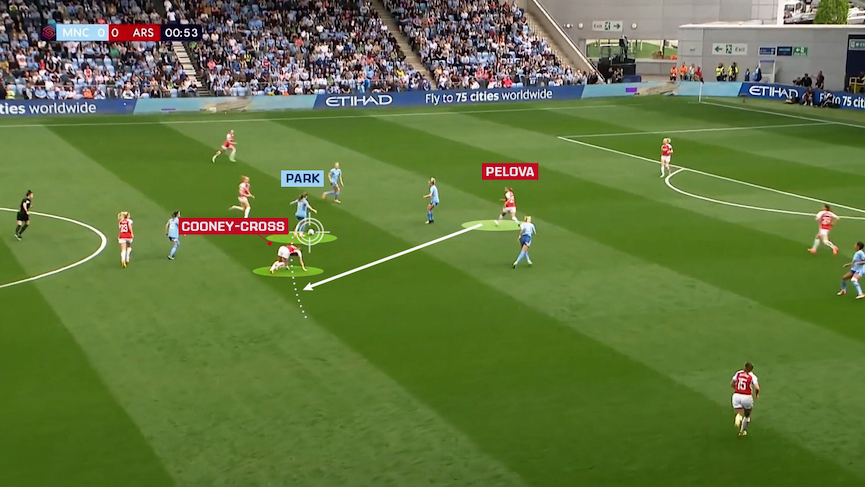
The pass has too much on it, however, and Jess Park is onto it. It doesn’t work on this occasion but you can see from the first goal kick that Arsenal want to keep the ball central as much as possible when playing in their own half.

This turnover comes to nothing, what Arsenal don’t want is to turn the ball over to the City wide players. Arsenal also quickly get players back and City are forced back to the halfway line, conceding possession centrally was easier for Arsenal to recover from due to the number of bodies they could get back. However, they did not do it often in any case.

The next time Zinsberger has the ball, she again rolls it straight to Pelova.

Cooney-Cross makes that blindside run off Kelly again but the space does not quite present itself to pass due to Hemp’s out to in run towards the ball.
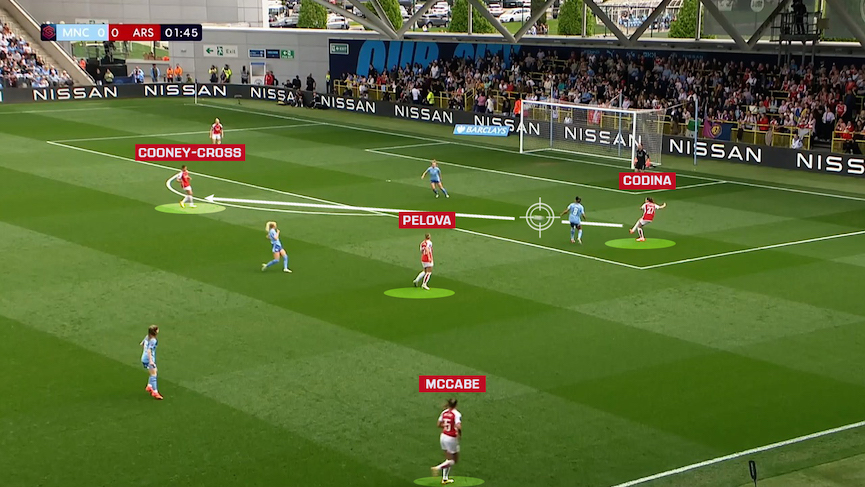
Pelova goes to Codina but you can see that McCabe is not really showing for a pass by the touchline. This is deliberate, Arsenal don’t want to play in their full-back areas too much. Instead Codina plays the ball back into a central area to Cooney-Cross.
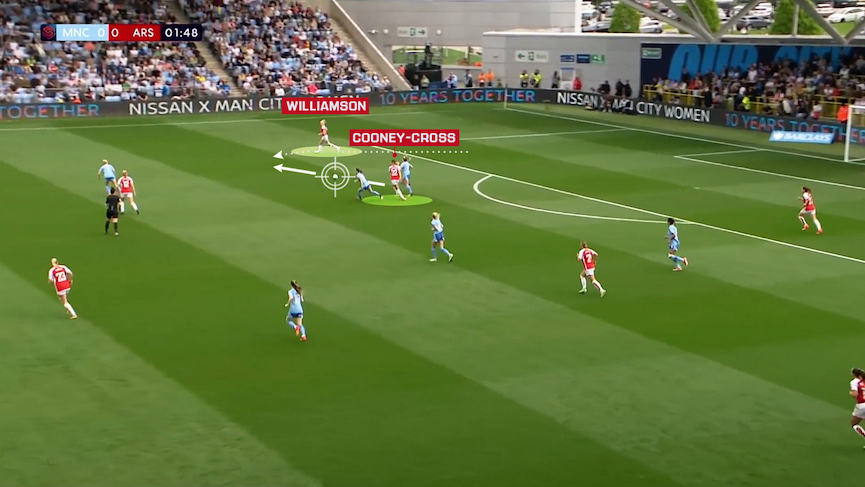
Cooney-Cross shifts the ball over to Williamson who has created an angle for her. Much like McCabe on the other side, we see Emily Fox is not in the shot here, she is not showing for the pass. Again, that is deliberate, Arsenal don’t want their full-backs to have the ball deep in Arsenal territory where City are strongest.

Williamson floats a pass up the line and then Arsenal are out of City’s pressure. The pass goes to Mead, this is where Arsenal are happy to have the ball wide, in City’s half.

Zinsberger receives a back pass from Cooney-Cross here and we can see she is waiting for that box shape between Williamson, Codina, Pelova and Cooney-Cross to reassemble.
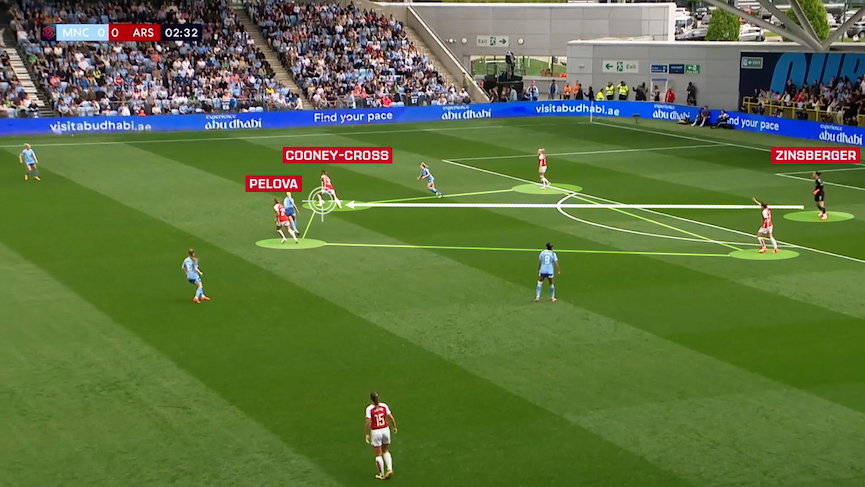
Once again, the ball goes to one of the central midfielders, Cooney-Cross on this occasion, from the goalkeeper and, once again, we see neither full-back is close to the action because Arsenal don’t want to get tricked into playing into them too early.

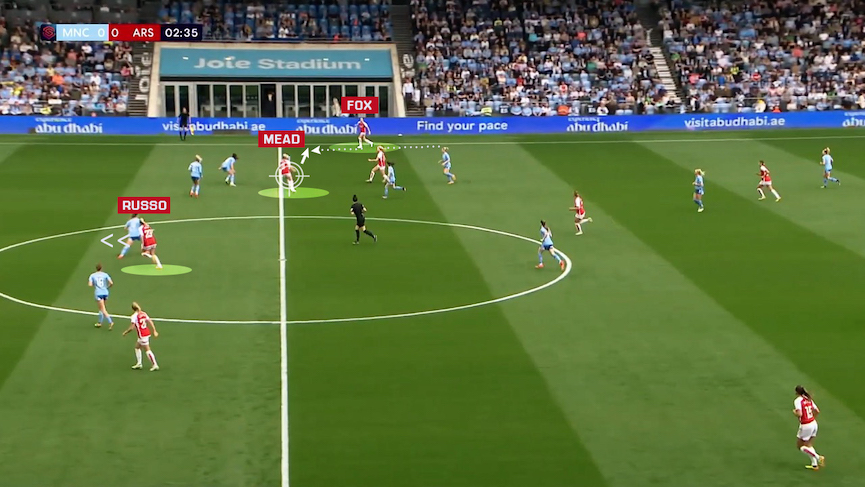
Cooney-Cross passes to Mead who then flicks the ball wide to Fox and Arsenal are away. From here, Russo is found in the right channel and Arsenal force a corner. This plays into what Eidevall said in his November post-match press conference about being central early in the build-up and going wider later when City’s wingers are less involved in the game since they don’t really track back.

I’ll not labour the point about Arsenal building centrally in deep areas much more but here is another good example. Ordinarily, Codina would probably switch the ball to McCabe in this scenario if Arsenal were playing another WSL team. But instead, Russo drops to ‘connect’ centrally and Codina finds her.

Russo bumps the ball off to Cooney-Cross first time and now you see that McCabe is no longer in the shot, she is on her bike.
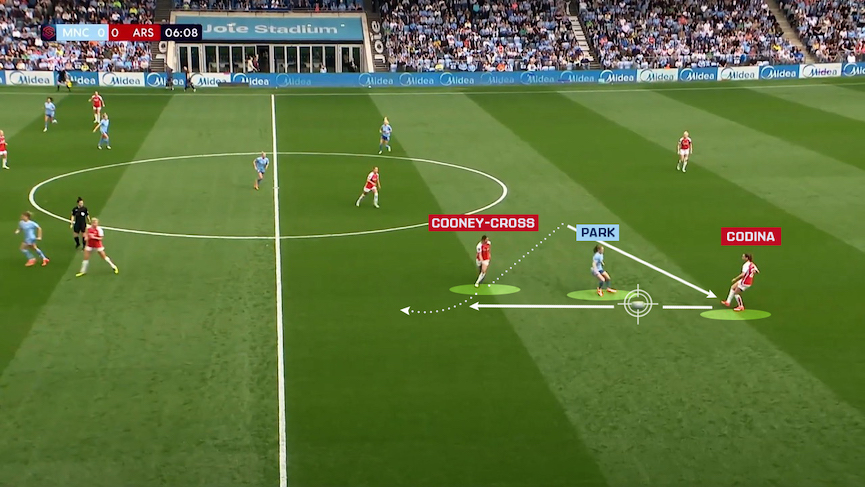
Cooney-Cross comes back to Codina and, again, makes a nice little blindside run off Jess Park to get the ball back.
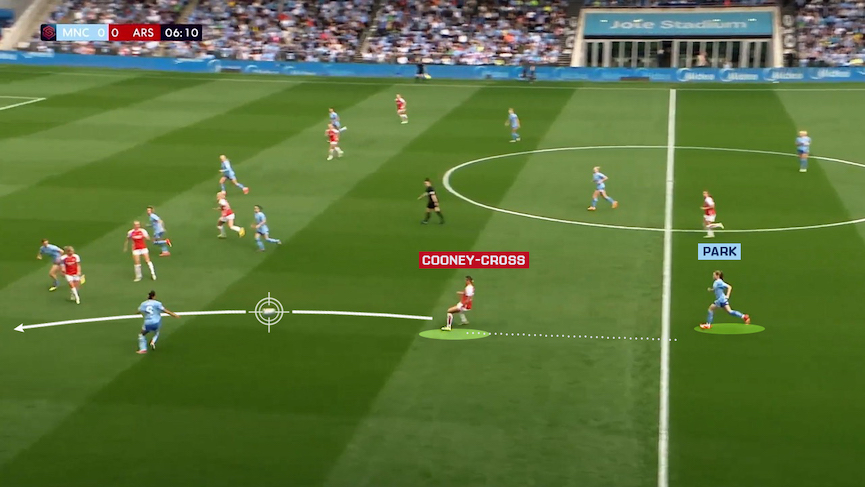

Now Arsenal want to go wide and Cooney-Cross finds the run of McCabe deep into City territory. Arsenal did pass the ball away from City’s pressure very well on Sunday and Eidevall pointed to the difference between this game and the one in November, where Arsenal struggled with the City press and opted to be direct in response (you can read my analysis of that game here, which made that exact point, that they played for territory instead of possession).
After this game, Eidevall told Arseblog News, ‘I think it was some of the best build-up football that we have played this season. It’s very difficult to play away Manchester City’s pressure. I think we did it ever so well. What we lacked in the first half was what did we do after that.’ Let’s look at some examples which, in truth, have been regular themes of the season, of Arsenal building well but lacking decisiveness in the final third.

Here’s a very good example. Once again we see the central build-up with Williamson passing to Pelova. Once again, Emily Fox is not in the picture because Arsenal don’t want their full-backs on the ball deep in their own half.

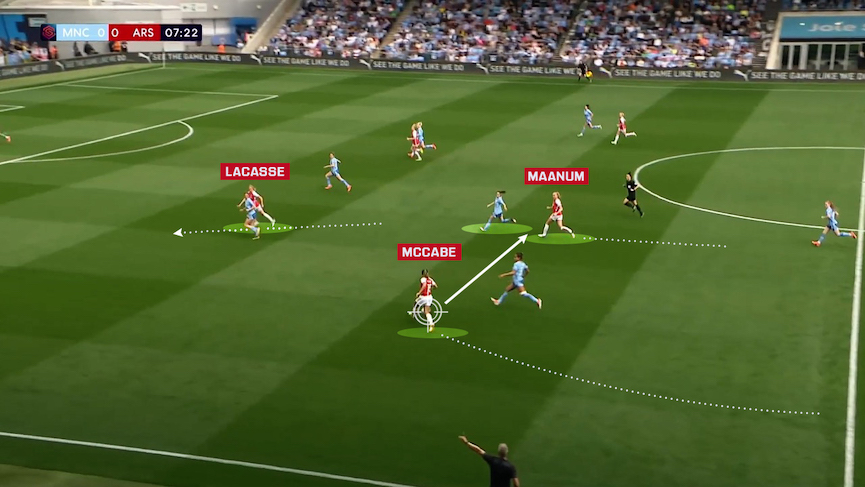
Pelova hits a nice diagonal pass and this is a good situation. McCabe should pass the ball to Lacasse down the line here but comes back in-field to Maanum.


Maanum isn’t expecting the pass because she is sprinting forward and well-marked in any case, she is off balance when she receives the pass and Hasegawa wins it back. Arsenal have been too circumspect with playing balls in behind all season.
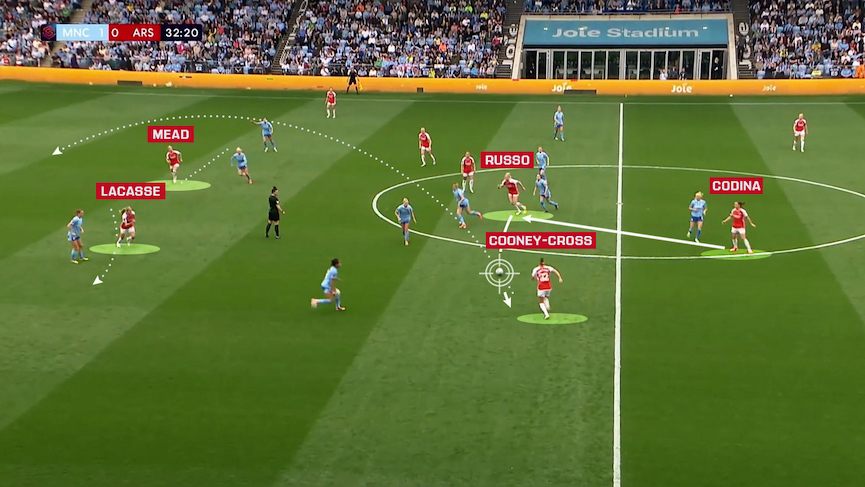
We see it again here, Russo drops deep again to connect with Codina and pops the ball off to Cooney-Cross. Ideally, this would be a good situation in which to drop the ball over the top of the City backline but Mead, who has wandered into the space Russo has vacated, and Lacasse haven’t stayed onside. Lacasse quickly runs backwards but that takes her momentum away from goal.

Cooney-Cross has to feed the ball into Lacasse’s feet but her bodyweight is shifted away from goal because she has to run backwards to stay onside. The ball to Mead in behind is also no longer on and City win the ball back easily.

We see more of that staticness Eidevall described here. As McCabe surveys her options here, Maanum and Pelova have both pushed on too early in the move.

McCabe comes back to Codina and again, we see nobody is really making a run or a movement to threaten City’s defensive organisation or a drag a player out of position. Instead, Pelova and Maanum are not having to run backwards and away from goal.

Codina finds McCabe and she passes to Maanum with her back to goal and on her left foot. Russo and Pelova, the most advanced players, are watching the ball but not the space and aren’t moving. Maanum tries to shift this pass wide to Lacasse, who has stayed right over on the touchline where City would want her to be but doesn’t connect and City have the ball back. Arsenal lacked ball security and smart movement in City’s half in the first half. It is significant that the winner in second half stoppage time comes from a Kim Little ball into a threatening Blackstenius run, those are the exact elements Arsenal missed in the first half.

Perhaps the starkest example of poor decision making in the final third happens in the closing moments of the half. Pelova brilliantly forces a turnover from Hasegawa here and Arsenal are in a great situation.
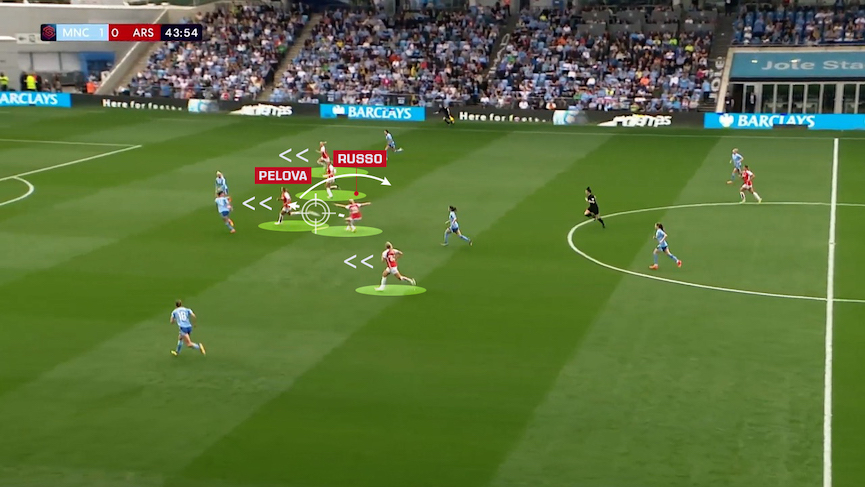
It is difficult to understand why Russo opts to shoot here given the distance from goal and the very presentable passes in behind available. The shot hits the back of Pelova as she runs forward. Again, the unwillingness to play through balls has been a real weakness for Arsenal this season.
Kim Little came on at half-time. Arseblog News asked Eidevall why the skipper didn’t start, especially with the emphasis on central ball progression, ‘When you don’t start Kim Little, that bears a question. Sometimes you need to think about how your team needs to look at the end of the game, and not only at the start of the game, also what’s going to fit the best for the team. And, of course, there are always considerations through the whole training week that comes into individual load and management that’s not known to you guys, but it’s known to me and that’s of course information I need to deal with as well.’ The suggestion seemed to be she wasn’t fit for 90 minutes and Arsenal prioritised having her at the end of the game as opposed to the beginning.

Here we see Little dropping deep to connect with Codina. Hasegawa follows her and this will become significant later in the move.
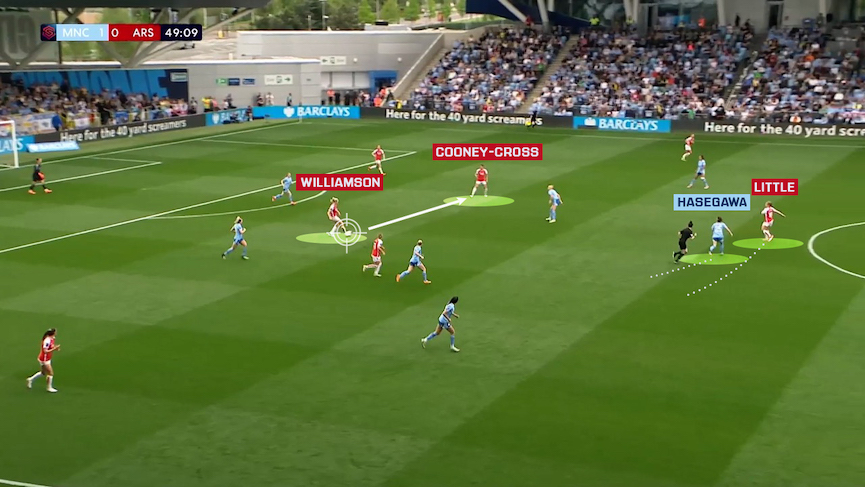
Whereas Maanum had a tendency to start high and have to drop towards the ball with her back to goal, Little started a little deeper and then turned and ran into space.
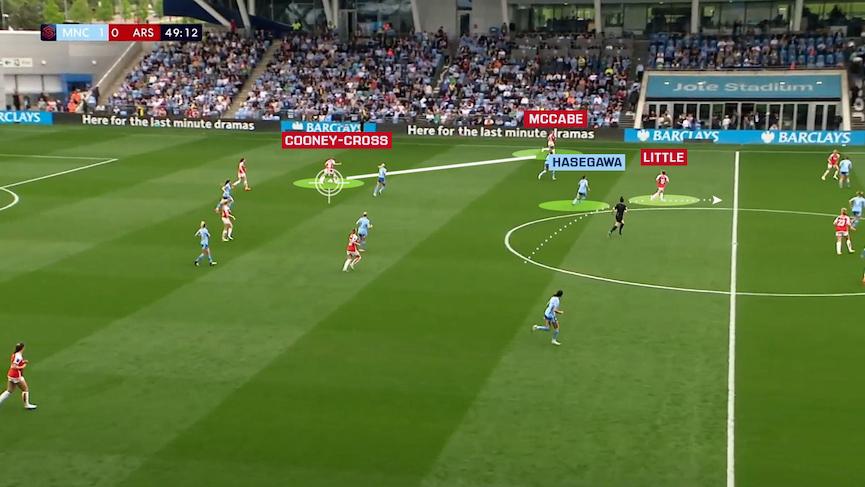
As the move unfolds we can see Little getting away from Hasegawa because she has dropped a little, taken Hasegawa with her and created space to run into.
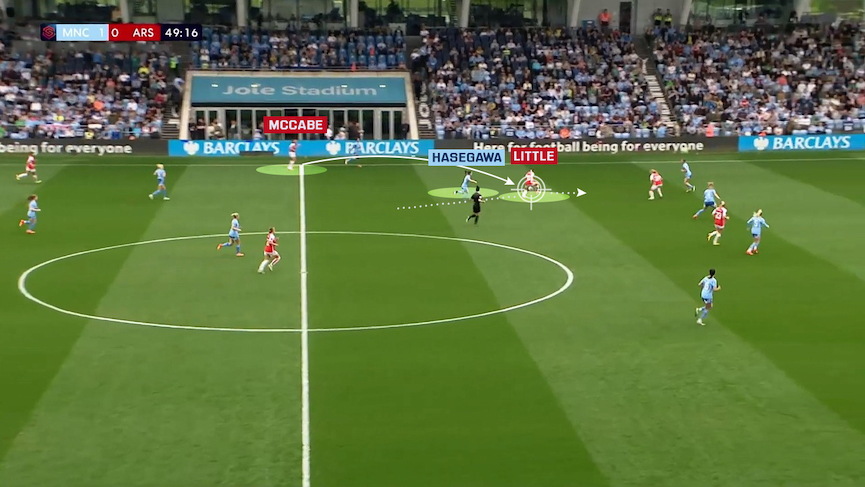
When McCabe receives the ball from Cooney-Cross, Little has picked up space between the lines with Hasegawa moved from her position and now Arsenal are in a good attacking situation. The division between Arsenal’s strong build-up play and their forward line was too definite in the first half and lacked a connector. Little gave the team that connection.
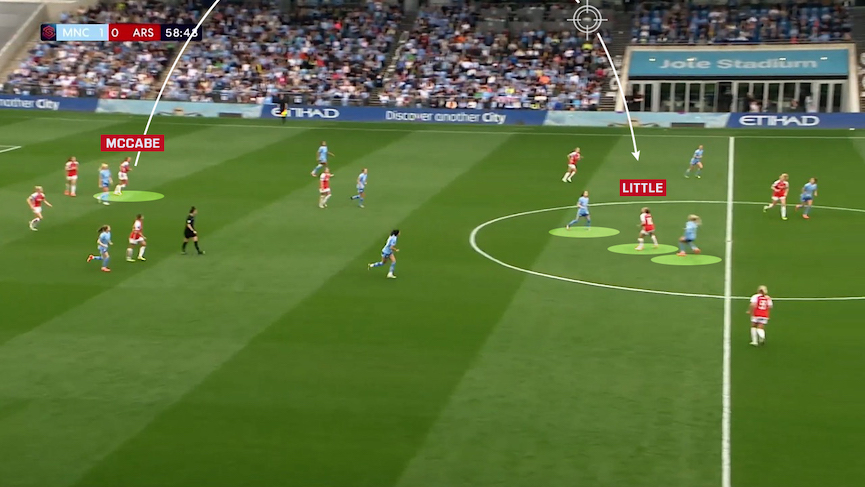
And on the occasions when Little was required to collect the ball with her back to goal- a scenario where we saw a number of moves die in the first half- well, just look at how she deals with this up and under clearance from McCabe.
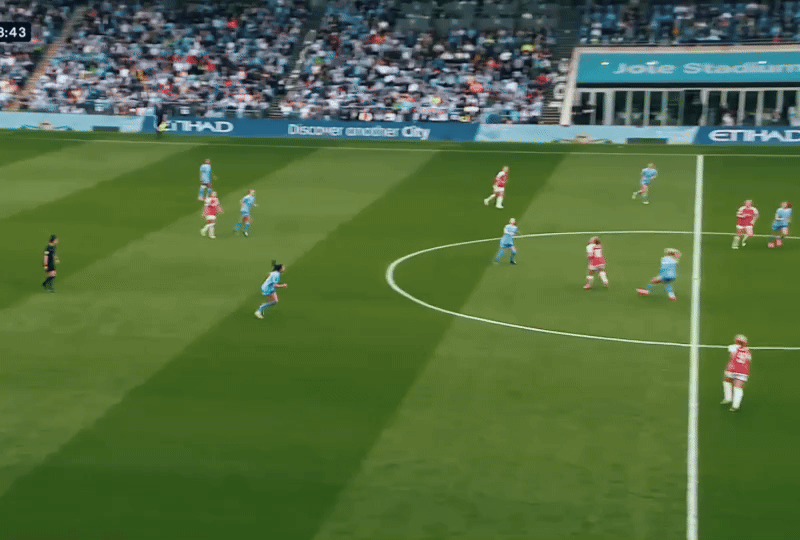
Even when she wasn’t able to start attacks, she was able to prevent Manchester City from taking the ball doing so themselves.

Arsenal began to push City back a little- we should acknowledge that City were more willing to sit back too given their position in the table, they wanted to protect the result. Little gave Arsenal some missing connection in the middle third and Blackstenius was introduced on 62 minutes to give Arsenal greater threat and movement in behind. Here we see McCabe, now at right-back from where she assisted Stina’s winner against City in November.
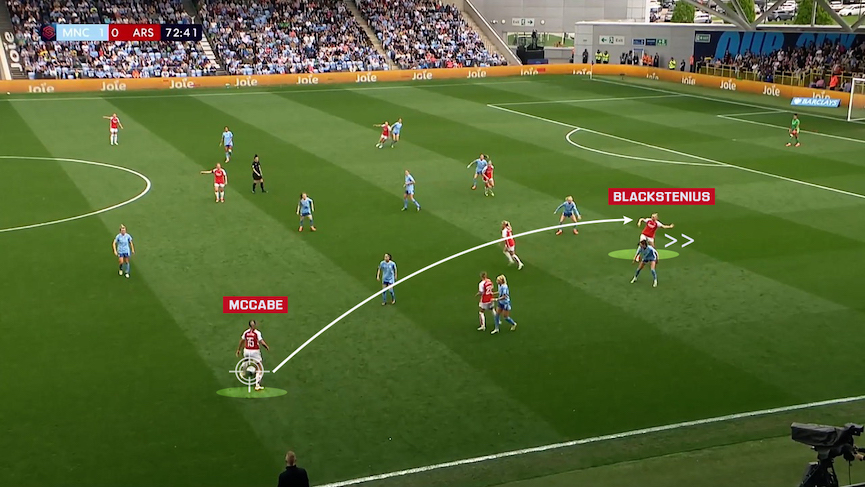
As the move unfolds, Blackstenius is consistently pushing against City’s defensive line (which will become significant for the winning goal) and offering the ball in behind.

McCabe drops the ball in behind for Stina here. She volleys over the bar from this position but now Arsenal have the movement and threat in behind that was missing in the first half.


Here’s a good example of how Little and Blackstenius each changed the game in the different departments of the pitch. Little skips away from Park’s pressure here with typical ease and drives into space.

When Williamson receives the ball here we see Blackstenius in her trademark pose, pushing the opponent’s defensive line, bending her run and pointing for the ball to be played. Williamson’s attempted through pass actually ends up hitting Mead by accident but Mead wins the foul and Arsenal get a free-kick in a dangerous position. Little gave Arsenal their platform back, Blackstenius gave the team more threat in behind.
Those elements combine in the most devastating way for the winning goal. Little receives the ball and where Arsenal had been either too conservative to pass in behind, or else lacked runners, Little plays an inch perfect through pass and Blackstenius is attacking it positively on the last line of City’s defence.
The pass from Little 😱
Blackstenius is there to head home for @ArsenalWFC!#BarclaysWSL pic.twitter.com/g4zWXgyQiI
— Barclays Women's Super League (@BarclaysWSL) May 6, 2024
In the first half, Arsenal’s build up was very good. They resisted City’s pressure well and weren’t forced into many turnover situations in their own half. They used a central box to escape the press but couldn’t elevate that platform in the middle and final thirds. Little resecured the middle third for Arsenal, Blackstenius make the difference in the final third. It was a pair of substitutions that clutched victory from the jaws of defeat.





Thanks for this. It helped me to understand the first half much better
These articles really are a technical lesson in football tactics. Great work! – Now I understand what I was seeing.
There are a few star names in the Arsenal Women’s side, but it was Kim Little that changed them from a side to a team in this game.
Thank you for this, Tim. I really enjoy these articles. I was surprised at pretty much all commentators stating that City were on top in the first half because of their successful press which fell awa in the second. That was not the game I watched! Playing Williamson, Codina, Pelova and Cooney-Cross as a box with the off the shoulder runs worked well. All four players were happy to take the ball under pressure and pass centrally, not square but centrally both vertical and horizontal. It was a failure to connect the midfield to the forwards that was the problem in… Read more »
Cheers, Tim. Confirms my sense that we were decent in the first half except for the perennial failure to make it count in the final third. I was wondering (watching on telly) why I couldn’t see Katie or Emily when Manu was passing out from the back – now I know why! City are a team that look so smooth, so technical, lovely quick passes, great movement, etc. They are a well-oiled threshing machine. But machines cannot adapt in the way a human can, and this is *their* perennial problem. (Or rather Gareth Taylor’s problem.) They have one gear. And… Read more »
great words, I want to see how City will behave in the CL
I always bang the drum for Kim and l’ll do it again….. She is in my opinion still one of the very best players in the world !
Absolutely agree – Kim should have won the Ballon d’Or at least once.
An example I noticed in the City game was that their Captain Greenwood always looked nervous going forward in the 2nd Half when she realised who she was facing, but she was not at all so in the 1st Half.
All this explains the science behind present day football and why a goalkeeper is used as an outfield player, something I wasn’t aware of. In future I won’t criticise ‘playing out from the back’ .
Thank you for explaining.
we need someone to run along Stina in those running in behind situations, because the goalie focusses her attention in closing the angle to Stina, and in the majority of the cases denied the goal to Stina. when another attacker is approaching towards the goal, make hesitation on the goalie and defenders giving more probability to score, but need to be trained and choreographed on training sessions. Thank you Tim.